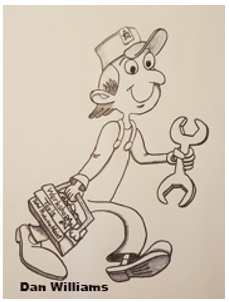President, PCS Inc., www.pcspress.com
 When I was younger, I would love to look at the stone carvings on the outside of the older buildings and also at the wood carvings on the doors and furniture inside. Today, I love to look at antiques that great artisans of the past carved. I feel as if the energy of the craftsperson is still in the art object and is available to me – to enrich my life.
When I was younger, I would love to look at the stone carvings on the outside of the older buildings and also at the wood carvings on the doors and furniture inside. Today, I love to look at antiques that great artisans of the past carved. I feel as if the energy of the craftsperson is still in the art object and is available to me – to enrich my life.
Prior to 1900, many people were highly skilled, true artisans: leather workers, silver and bronze casting, blacksmithing, glass blowers, potters, wood carvers, ironsmiths, farmers, bootmakers, saddlers, hat maker, jewelers, glassblowers, copper smith cooper, lapidary, miller, brewer, confectioner, watchmaker, tinsmith, glazier, maltster, wood-turner, saddler, shipwright, scale maker, sail-maker, candle maker, engraver, cutler, stone cutter, canister-maker, furrier, cap-maker, typesetters, bookbinders, and wheelwrights, etc. Often within each trade was a mastership apprenticeship program where a young person could study to learn how to become a master and then live as a highly skilled artisan. Then, along comes Frederick Taylor and Henry Ford with their simplification of work and the assembly line and many of those high skilled jobs disappeared and for most people work became tedious, repetitious and boring.
The question I ask you, “Can there be a human side of lean when so much work is designed for robots not humans?
Once, not too long ago, I was at a Hitachi plant in Japan watching a man picking up a piece of metal and placing it into a machine. The machine moved quickly doing something to the piece of metal and then the man simply removed it and placed another part again into the machine. After a few minutes, as I was watching, the man raised his hands and shouted at the top of his lungs with complete frustration. Then after a few seconds, he took a few breaths and repeated the process all over again, placing a small piece of metal into the machine. A few minutes later, not too far from the man with the small piece of metal, a woman was carefully soldering two wires onto a clock mechanism using extreme dexterity and focus. I asked her, knowing the answer, ‘How do you like your work?” She answered, “I love it.”
Both jobs were repetitious but one seemed to be driving the man crazy and the other, for the woman, was fulfilling. Why? I believe that good work requires concentration and allows a person to reach towards mastery.
But, a higher question is, can we today design work that is both challenging and fulfilling for human beings and to also be productive and profitable for the organization? We want the product that we make to enrich and satisfy our customers but we are willing to do the reverse within our own company. I like, very much, the JIT idea that the next worker is my customer, and I should never pass a defect to them or give them work that belittles their human dignity.
Canon Corporation in the past had people working on an assembly line, then they shifted to a conveyor belt with maybe a two to three minute takt time and finally put people into manufacturing cells where one woman was able, on her own, build an entire copier with over 1000 parts and being much more productive than the two previous processes. Through management's encouragement, support, development and training, people are capable, just as they were in the 1800’s, to accomplish amazing things.
China has succeeded over the past twenty years on very “cheap” labor attracting manufacturing jobs from America and elsewhere, but today China is dynamically shifting to more value-added skills. If we are to succeed in the 21st Century, on many levels, we also must make a major shift towards value-adding work - challenging people to maximize their human potential and expand towards their highest capabilities.
 “I am a highly skilled lean mechanic. Just find me a machine and I will show you how to make sure it never works again.”
“I am a highly skilled lean mechanic. Just find me a machine and I will show you how to make sure it never works again.”
artist: Dan Williams


